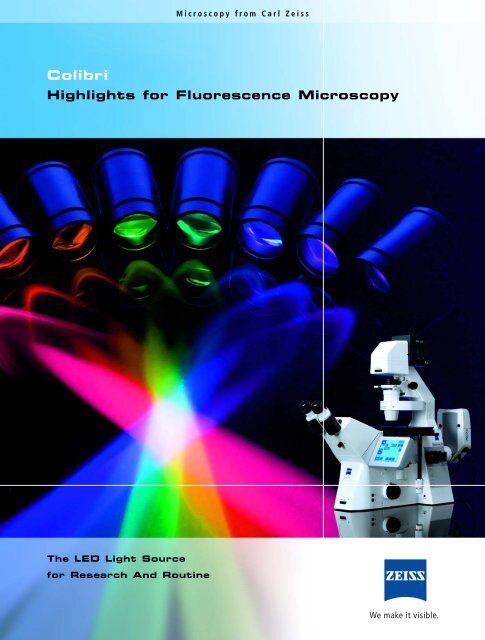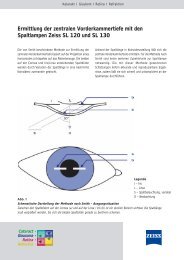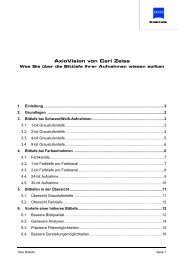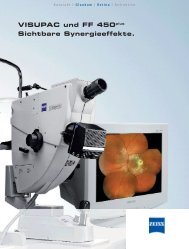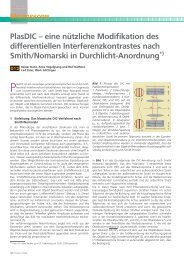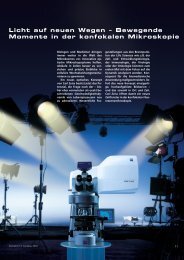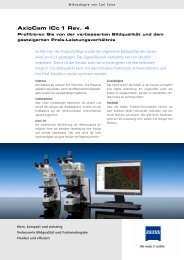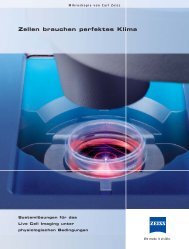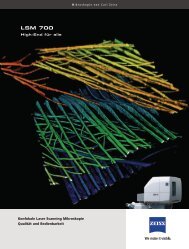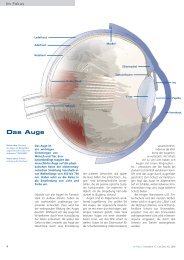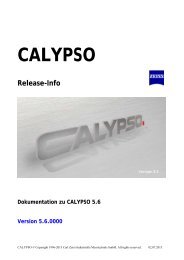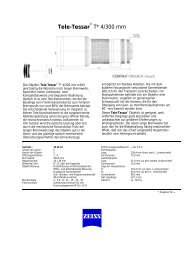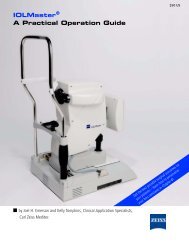Colibri - Carl Zeiss
Colibri - Carl Zeiss
Colibri - Carl Zeiss
You also want an ePaper? Increase the reach of your titles
YUMPU automatically turns print PDFs into web optimized ePapers that Google loves.
<strong>Colibri</strong><br />
Highlights for Fluorescence Microscopy<br />
The LED Light Source<br />
for Research And Routine<br />
Microscopy from <strong>Carl</strong> <strong>Zeiss</strong>
2<br />
New Light in<br />
Fluorescence<br />
High-performance LEDs (Light Emitting Diodes) taking<br />
the place of a white light source – with this innovation<br />
<strong>Carl</strong> <strong>Zeiss</strong> is breaking new ground in fluorescence<br />
microscopy. <strong>Colibri</strong> is the first light source that<br />
enables you to take full advantage of the countless<br />
benefits offered by LEDs for fluorescence applications.<br />
Each individual LED delivers only a precisely<br />
defined range of the spectrum. No undesired light is<br />
emitted, which means that there is also no need to<br />
suppress it. As a result, you benefit from extremely<br />
high-contrast images with a high dynamic range –<br />
images that will enable you to achieve meaningful<br />
scientific results in tasks ranging from simple routine<br />
applications through to complex applications in Live<br />
Cell Imaging.<br />
• Precise adjustment of intensity for optimum<br />
protection of samples<br />
• Switching times in the microsecond range<br />
• Long life, high economic efficiency<br />
• Stand-alone operation and full integration into<br />
the AxioVision system software<br />
The task of developing increasingly differentiated<br />
fluorescence techniques to decode the secrets of life<br />
is an area to which <strong>Carl</strong> <strong>Zeiss</strong> is devoting particular<br />
attention. And we have given our work in this field<br />
a name: FluoresScience. We are placing the emphasis<br />
here on research involving living cells and aim to<br />
make the best tools available for both research and<br />
routine tasks, now and in the future. We are therefore<br />
constantly driving forward the development of<br />
innovative solutions – one example being a highquality<br />
light source that performs at the limits of<br />
what is technically possible today.
4<br />
Designed for The Highest Speeds:<br />
Switching Times Enter A New Dimension<br />
<strong>Colibri</strong>’s super-fast control makes it a convenient and<br />
ideal solution for all high-speed applications. Each LED<br />
can be switched on and off and adjusted in the microsecond<br />
range. For complex applications in particular,<br />
the possibility of combining wavelengths flexibly and<br />
of coupling an external white light source opens up a<br />
wide range of possible uses.<br />
From UV to dark red in<br />
microseconds<br />
With <strong>Colibri</strong> you have ten LEDs at your fingertips, ranging<br />
from UV through to dark red, via the full spectrum<br />
commonly used in fluorescence microscopy. Up to four<br />
LED modules can be used in parallel. You can set the<br />
desired intensity with precision in percentage steps for<br />
each individual LED using a control panel or with the<br />
helpoftheAxioVisionsystemsoftware.Theillumination<br />
can be adjusted individually depending on the sensitivity<br />
of the sample. This prevents unnecessary bleaching<br />
and ensures your sample is optimally proteced.
Time lapse series: HeLa cells<br />
red: 2B histones - DsRed; green: HIV-1 REV - mutant YFP<br />
K. Hadyan and H. Wolff, GSF, Institute of Molecular Virology,<br />
Neuherberg, Germany<br />
If export is blocked, the mutated HIV-1 REV protein is<br />
redistributed into the cell nucleus<br />
Optoelectronics for faster<br />
switching<br />
No switching mirrors, no mechanical shutters, no<br />
filter wheels – with <strong>Colibri</strong> switching takes place<br />
solely using optoelectronics. Nothing has to be<br />
moved – only the current is switched. Thanks to this<br />
sophisticated system employed by <strong>Colibri</strong>, switching<br />
times in the microsecond range can be achieved<br />
between the different LED modules and between<br />
the different intensity settings of a single LED.<br />
Optimum protection for<br />
living samples<br />
When it comes to analyzing rapid processes in living<br />
cells with high temporal resolution, <strong>Colibri</strong>’s extremely<br />
high switching speeds make it the light<br />
source of choice. Thanks to the excellent signal-tonoise<br />
ratio and high dynamic range of the images,<br />
it is possible to identify the finest details despite low<br />
illumination intensity. The possibility of adjusting the<br />
intensity in fine steps ensures maximum protection<br />
for living samples and thereby enables you to achieve<br />
considerably longer observation times. With <strong>Colibri</strong><br />
you will easily find the ideal compromise between<br />
illumination, phototoxicity and bleaching.<br />
Greater options for<br />
fixed specimens<br />
Speed and steplessly adjustable illumination intensity<br />
offer numerous advantages with fixed samples<br />
too. In particular, the possibility of freely adjusting the<br />
various wavelengths – which can also be employed<br />
simultaneously – opens up entirely new possibilities<br />
for scientific analysis. Experiments that were previously<br />
time-consuming and labor-intensive, such as<br />
searching for a small number of cells with a certain<br />
combination of differently labeled proteins, are now<br />
incredibly simple.<br />
LED modules covering the available spectral range from UV<br />
through to dark red<br />
5
6<br />
<strong>Colibri</strong>’s Highlights:<br />
Performance in Every Detail<br />
What makes <strong>Colibri</strong> top-class technology is its consistent<br />
orientation toward users’ requirements. Every<br />
technical detail has been tailored to provide the best<br />
possible support for your fluorescence applications –<br />
from routine through to high-end. With an efficient<br />
workflow, extremely simple operation and reliable<br />
reproducibility.<br />
Steplessly adjustable intensity<br />
The output of each individual LED can be adjusted<br />
precisely to the sample and application in percentage<br />
steps, depending on your particular requirements.<br />
It is possible to switch the LEDs individually,<br />
in sequence or simultaneously in any combination.<br />
Thermal and mechanical stability<br />
<strong>Colibri</strong> converts electricity into light highly efficiently,<br />
and only minimally into heat. The fact that<br />
so little heat is generated by the LEDs also means<br />
that <strong>Colibri</strong> does not burden the microscope with<br />
heat. And as the optoelectronics perform switching<br />
without any movement, there are no vibrations,<br />
noises or time delays.<br />
Stable emission<br />
The LEDs have very high emission stability. The fluctuations<br />
familiar with arc lamps are therefore avoided.<br />
Long life<br />
The LEDs have an extremely long life, lasting for<br />
thousands of hours. In contrast to other light<br />
sources, they are incredibly robust and you can<br />
switch them on and off as often as you like without<br />
causing damage. The LED modules are only<br />
switched on when light is actually required, further<br />
increasing the actual life time compared to light<br />
sources that are illuminated continuously.<br />
Reliable reproducibility<br />
As <strong>Colibri</strong> offers extraordinarily high stability and<br />
extremely long life, the reproducibility of the illumination<br />
conditions is also significantly higher than<br />
with other light sources in fluorescence microscopy.<br />
This is a decisive advantage, especially for medical<br />
documentation in accordance with GxP guidelines.
High contrast<br />
The narrow-band emission of the LEDs means less<br />
stray light in the background of the images of your<br />
samples. The images have a higher dynamic range.<br />
Consequently, even the finest structures and the<br />
weakest signals can be detected more easily.<br />
High investment security<br />
Thanks to <strong>Colibri</strong>’s modular structure, it will be possible<br />
to retrofit it at any time if new LED technologies<br />
become available.<br />
Superior economic efficiency<br />
The long life of the LEDs ensures that the cost of running<br />
<strong>Colibri</strong> remains very low. And with <strong>Colibri</strong> there<br />
is no need for the laborious process of changing and<br />
possibly adjusting super-pressure lamps (HBO/XBO/<br />
metal halide).<br />
New degree of flexibility<br />
The LED modules and beam combiners can be easily<br />
changed, meaning that <strong>Colibri</strong> can be adapted<br />
simply as the requirements of your applications<br />
evolve. Via the integrated interface, you also have the<br />
option of using a white light source, coupled using<br />
a light guide, for applications that are not yet covered<br />
optimally by LEDs.<br />
7
8<br />
Convenient, Flexible, Easy to Operate:<br />
Perfect Interaction As Part of A System<br />
Outstanding fluorescence, unparalleled optics, a huge<br />
range of possible applications – when integrated into<br />
a system and interacting perfectly with a microscope<br />
and the AxioVision software, <strong>Colibri</strong> really excels. Its<br />
simple operation is a particularly convenient aspect for<br />
the user. <strong>Colibri</strong> can be controlled in AxioVision or<br />
using a control panel. And the LEDs and beam combiners<br />
can be exchanged quickly with just a few operations<br />
to allow you to change wavelengths.<br />
Intelligently integrated into<br />
AxioVision<br />
When used in combination with the AxioVision system<br />
software, <strong>Colibri</strong> reaches its full potential. Convenient,<br />
fully automated processes can be created by<br />
integrating the LEDs, switching prism and shutter of<br />
the recommended HXP 120 white light source into<br />
hardware settings. Control of <strong>Colibri</strong> is integrated<br />
into AxioVision 4.6 and does not have to be purchased<br />
separately. All the components of the system<br />
are synchronized with a high degree of precision.<br />
Control of the LEDs is taken over directly by the<br />
<strong>Colibri</strong>’s user interface<br />
Left: LED modules in continuous operation mode<br />
Right: in gated mode, where the LEDs are switched using<br />
trigger signals<br />
digital cameras of the AxioCam family via a trigger<br />
signal. The advantage of this is that the LEDs can be<br />
operated in gated mode and sensitive samples are<br />
illuminated only during image acquisition. Optimum<br />
acquisition conditions are achieved, as each individual<br />
LED can be adjusted precisely and independently.<br />
This means that equidistant image acquisition<br />
can also be achieved with multichannel time lapse<br />
series, something that is particularly important for<br />
the quantitative analysis of the results.<br />
Perfect complement to the<br />
Cell Observer ® HS<br />
Extremely high switching speeds and precise, highly<br />
reproducible control make <strong>Colibri</strong> the ideal light<br />
source for high-speed systems such as the<br />
Cell Observer ® HS. All the benefits and possibilities<br />
are only utilized fully when the following components<br />
are used in combination to create a fully integrated<br />
total system:<br />
• <strong>Colibri</strong> illumination system<br />
• High-speed AxioCam HS camera<br />
• Fast piezo focusing<br />
• Fast data streaming<br />
• Monitoring and control using<br />
AxioVision<br />
Axio Observer.Z1 with <strong>Colibri</strong> and the external HXP 120 white light source;<br />
monitoring and control using AxioVision
Simple changing of LED modules<br />
Simply attach and start using<br />
your microscope<br />
The way in which <strong>Colibri</strong> is operated is extremely<br />
simple and very much geared toward practical<br />
requirements. You simply attach the light source to<br />
the microscope’s reflected light port and it is ready<br />
to use straight away. It is possible to control it either<br />
as a stand-alone unit or via AxioVision. This means<br />
that operation on manual microscopes as well as on<br />
fully automated systems is as simple as possible. The<br />
control panel is used to switch each LED module on<br />
and off and set its intensity in percentage steps.<br />
And thanks to the tactile control elements, you can<br />
operate the system reliably even while looking<br />
through the microscope. It is therefore possible to<br />
adjust the intensity of each LED optimally to the<br />
sample during observation. If required, a white light<br />
source can be coupled via the motorized switching<br />
unit, making it possible to use fluorescent dyes that<br />
cannot yet be optimally excited using today’s LEDs.<br />
We recommend the HXP 120 white light source<br />
with a long-life metal halide lamp, a heat protection<br />
filter and a very fast triggerable shutter. The<br />
<strong>Colibri</strong> control panel is used<br />
to switch over to and control<br />
the shutter of the HXP 120.<br />
Fast changing of beam combiners<br />
Rapid changing and simple<br />
expansion<br />
Changing the LED modules is a quick and simple<br />
task: remove the plug, undo the clamping screw,<br />
remove the LED module and insert a new LED.<br />
Exchanging the beam combiners is even easier:<br />
remove the mounting frame and insert a new frame.<br />
With <strong>Colibri</strong> there is no need at all for any laborious<br />
adjustment. In addition, each LED module is<br />
equipped with an ACR chip (Automatic Component<br />
Recognition) that enables the new module to be<br />
detected automatically. The ACR chip eliminates the<br />
possibility of incorrect operation and ensures that<br />
each module is correctly assigned to its position.<br />
Thanks to the modular structure, it is easy to expand<br />
the system if new applications demand additional<br />
wavelengths.<br />
Control panel in LED mode with simultaneous use of three<br />
wavelengths (left) and after switching over to external white<br />
light source (right)<br />
9
High-tech in Detail<br />
1 Positions for LED modules<br />
2 Plug contacts for LED modules<br />
3 Positions for beam combiners<br />
4 Deflection mirror<br />
5 Coupling to microscope<br />
6 Connection for electronics<br />
7 Motorized switching prism for changing<br />
between LED mode and white light source<br />
8 Coupling for liquid light guide<br />
Schematic view of <strong>Colibri</strong>’s design<br />
After the upper section of the housing has been<br />
removed, the top part can be accessed to change<br />
LED modules and beam combiners. The lower section<br />
of the housing, shown here as transparent,<br />
mainly contains electronics and optical adjustment<br />
elements and is not accessible.<br />
8<br />
1<br />
4<br />
6<br />
7<br />
3<br />
2<br />
3<br />
3<br />
5<br />
2<br />
1<br />
1<br />
1
Background Information<br />
<strong>Colibri</strong>’s outstanding contrast behavior can be<br />
explained by its light source characteristics. A white<br />
light source emits light across the entire spectrum.<br />
For the excitation of a fluorescent dye, however,<br />
only a small part of the spectrum is required, which<br />
is determined by the excitation filter. The rest of the<br />
undesired light has to be suppressed as efficiently<br />
as possible, as otherwise it will be superimposed<br />
onto the fluorescence signal and will reduce the<br />
contrast. Even the best fluorescence filters available<br />
do not achieve absolute suppression of undesired<br />
wavelengths. And each photon that finds its way<br />
to the detector contributes to the background,<br />
therefore causing deterioration in the signal-tonoise<br />
ratio.<br />
In contrast to the above, an LED emits only a narrow<br />
spectral band, outside of which no light is given<br />
out. A comparison can be seen in the two graphs.<br />
They represent a simulation calculated on the basis<br />
of genuine filter set data for a typical UV filter set.<br />
The graphs compare the use of a white light source<br />
with typical mercury line spectrum (top) with the use<br />
of a UV LED (bottom). The light that could not be<br />
suppressed by the filter system is shown greatly<br />
amplified in pale yellow in each case. As the LED<br />
does not emit any light outside its narrow emission<br />
band, undesired light contributes only minimally to<br />
the background.<br />
Beam combiners in mounting frames<br />
Technology<br />
Transmission (%)<br />
Transmission (%)<br />
100.0<br />
90.0<br />
80.0<br />
70.0<br />
60.0<br />
50.0<br />
40.0<br />
30.0<br />
20.0<br />
10.0<br />
0.0<br />
300 400 500<br />
Wavelength in nm<br />
600 700<br />
100.0<br />
90.0<br />
80.0<br />
70.0<br />
60.0<br />
50.0<br />
40.0<br />
30.0<br />
20.0<br />
10.0<br />
0.0<br />
300 400 500<br />
Wavelength in nm<br />
600 700<br />
Excitation spectrum of fluorescent dye<br />
Emission spectrum of fluorescent dye<br />
Transmission spectrum of excitation filter<br />
Transmission spectrum of beam splitter<br />
Transmission spectrum of emission filter<br />
Emission of light source<br />
Stray light components (shown amplified in<br />
relation to light emission)<br />
11
System Overview<br />
<strong>Colibri</strong> is recommended for use with the Axio Observer, Axiovert 200,<br />
Axio Imager, Axioplan 2, Axioskop 2, Axioskop 2 FS and Axioskop 40<br />
<strong>Carl</strong> <strong>Zeiss</strong> MicroImaging GmbH<br />
P.O.B. 4041, 37030 Göttingen, Germany<br />
Phone: +49 (0) 551 5060 660<br />
Fax: +49 (0) 551 5060 464<br />
E-mail: micro@zeiss.de<br />
www.zeiss.de/colibri<br />
Printed on environmentallyfreindly<br />
paper, bleached without<br />
the use of chlorine.<br />
Subject to change.<br />
46-0124 e 05.2007


